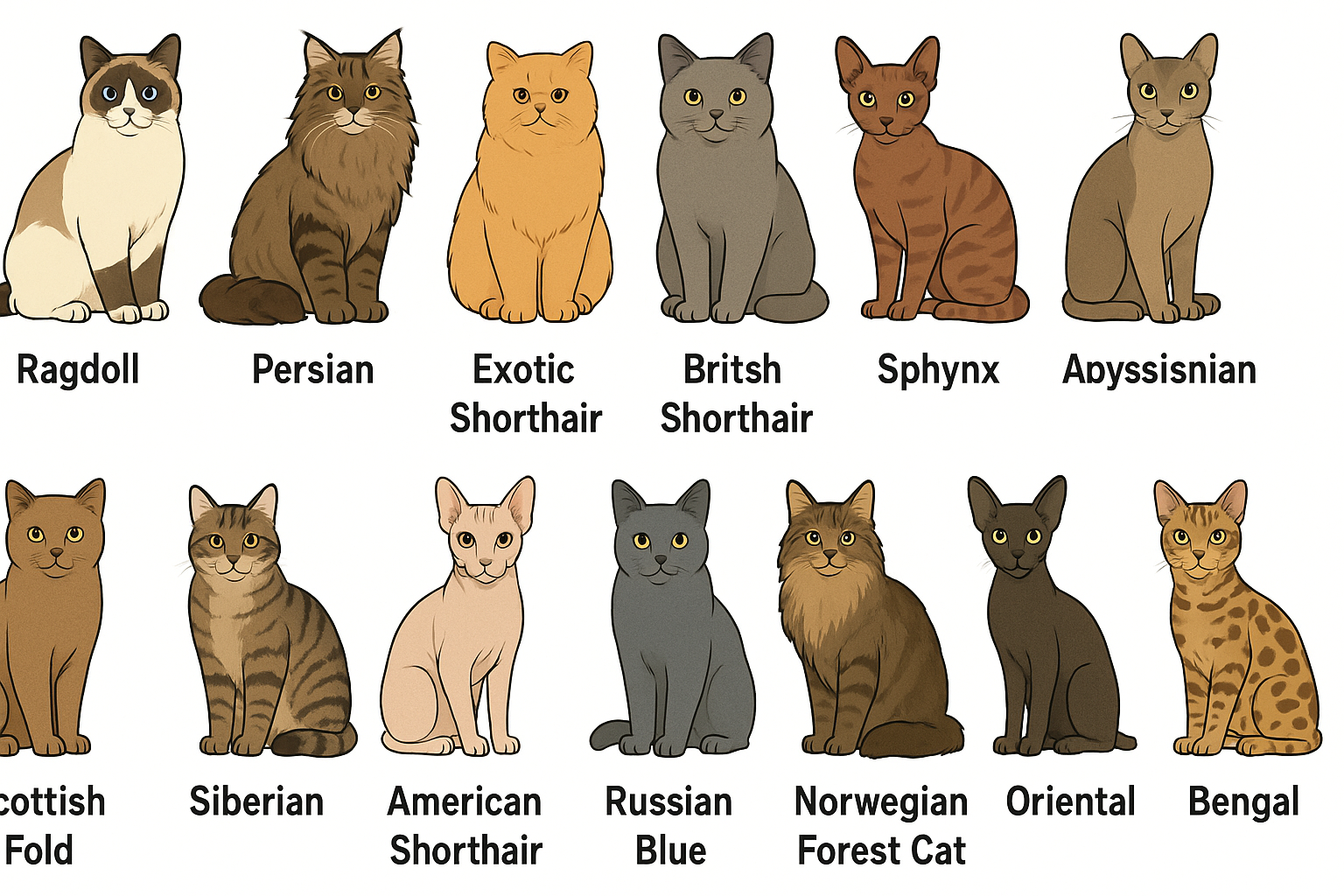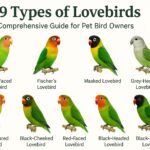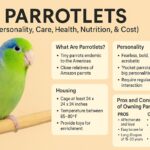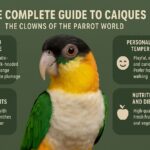The world of feline companions has seen shifting preferences over the years, with certain breeds capturing the hearts of cat enthusiasts more than others in 2025. According to recent registration statistics from the Cat Fanciers’ Association (CFA) and other major feline registries, specific breeds have risen to prominence based on their unique characteristics, temperaments, and adaptability to modern lifestyles.
This comprehensive guide explores the fifteen most beloved cat breeds of the year, offering insights into what makes each one special.
15 Most Loved Types of Pet Cats
1. Ragdoll
For the fifth consecutive year, the Ragdoll holds the title of the most popular cat breed. Known for their striking blue eyes and color-point coats, Ragdolls earned their name from their tendency to go completely limp and relaxed when picked up.
These cats are often described as “dog-like” due to their loyal and affectionate nature. They typically follow their owners around the home and enjoy being involved in household activities. Unlike more independent felines, Ragdolls crave human interaction and often greet family members at the door.
Ragdolls are medium to large cats, with males weighing between 15-20 pounds and females ranging from 10-15 pounds. Their semi-longhaired coat requires only weekly brushing to prevent matting, making them relatively low-maintenance despite their luxurious appearance.
While generally healthy, potential Ragdoll owners should be aware of their predisposition to certain health issues. According to veterinary studies, Ragdolls can be prone to hypertrophic cardiomyopathy (a form of heart disease) and respiratory problems. Regular veterinary check-ups are essential for maintaining their wellbeing.
Perfect for families with children or other pets, Ragdolls adapt well to various living situations, making them ideal companions for both apartment dwellers and homeowners with spacious accommodations.
2. Maine Coon
Maintaining its strong second-place position, the Maine Coon continues to captivate cat lovers with its impressive size and friendly disposition. As the largest domesticated cat breed, male Maine Coons often weigh between 20-25 pounds, while females typically range from 10-15 pounds.
Native to North America, specifically the state of Maine, these cats evolved naturally to withstand harsh winter conditions, developing tufted ears, bushy tails, and water-resistant shaggy coats. Their large, tufted paws act like natural snowshoes, allowing them to navigate snowy terrain with ease.
Despite their imposing size, Maine Coons are known as “gentle giants” in the cat world. They possess a playful spirit that often lasts well into adulthood, but they’re rarely destructive or hyperactive. Their social nature makes them excellent family pets, as they generally get along well with children, dogs, and other cats.
Maine Coons are highly intelligent and can be taught tricks and commands, much like dogs. Many owners report their Maine Coons playing fetch or learning to walk on a leash with proper training. Their distinctive “chirping” vocalization sets them apart from other breeds that typically meow.
According to the CFA, the Maine Coon has seen a significant surge in popularity since 2023, particularly among families looking for a robust, friendly cat with an impressive appearance. Their coat requires regular grooming, typically 2-3 times per week, to prevent matting and minimize shedding.
3. Persian
Moving up from fifth place in previous years to third in 2025, the Persian cat continues to enchant cat lovers with its luxurious coat and sweet expression. Recognized as one of the oldest cat breeds, Persians have been admired for their beauty and calm temperament for centuries.
Persians feature a distinctive appearance with a round face, short nose, full cheeks, and small, rounded ears. Their most notable trait is their long, flowing coat that comes in various colors and patterns. The breed can be divided into two facial types: the traditional “doll-face” and the more extreme “peke-face” with a flatter facial profile.
These cats embody tranquility, preferring quiet environments where they can lounge regally on comfortable surfaces. Unlike some more active breeds, Persians are content to observe household activities from a comfortable perch rather than actively participating. This makes them ideal companions for seniors or individuals seeking a peaceful pet presence.
The Persian’s gorgeous coat comes with significant maintenance requirements. Daily brushing is necessary to prevent painful matting and tangles. Many Persian owners schedule professional grooming sessions every 4-6 weeks to maintain their pet’s coat in optimal condition. Their facial structure also necessitates regular cleaning around the eyes to prevent tear staining.
Health-conscious potential owners should note that Persians, particularly those with extremely flat faces, might experience breathing difficulties and eye problems. According to veterinary journals, breeders have been working toward slightly less extreme facial structures to mitigate these health concerns while maintaining the breed’s characteristic appearance.
Despite the grooming demands, Persian cats remain highly sought after for their sweet personalities and stunning looks, with adoption waiting lists extending months for kittens from reputable breeders.
4. Exotic Shorthair
Often described as the “lazy person’s Persian,” the Exotic Shorthair holds fourth place in 2025’s popularity rankings. This breed offers the Persian’s beloved teddy-bear look without the extensive grooming requirements, making it an increasingly attractive option for busy cat lovers.
Developed by crossing Persians with American Shorthairs, Exotic Shorthairs maintain the Persian’s distinctive facial features and body type while sporting a dense, plush coat that’s much shorter and easier to maintain. Their round faces with large, expressive eyes give them an endearing, perpetually kitten-like appearance that many find irresistible.
Personality-wise, Exotic Shorthairs blend the gentle nature of Persians with slightly more playfulness. They form strong bonds with their human companions but aren’t typically demanding of attention. Their moderate activity level makes them suitable for various living situations, including apartments and homes with older children.
While their grooming needs are significantly less intensive than their Persian ancestors, Exotic Shorthairs still benefit from weekly brushing to reduce shedding and distribute skin oils. Like Persians, they may require occasional facial cleaning due to their facial structure.
Health considerations mirror those of Persians, including potential breathing issues and polycystic kidney disease. Responsible breeders screen for these conditions, and recent veterinary research indicates increasing awareness of breeding for healthier facial structures.
5. Devon Rex
Dropping slightly from third to fifth place in 2025, the Devon Rex remains one of the most distinctive and beloved cat breeds. Often referred to as “poodles of the cat world” or “alien cats,” Devon Rex cats are instantly recognizable by their large ears, high cheekbones, and short, wavy coat.
The Devon Rex’s most notable physical feature is its unique coat texture – soft, curly, and very short, resembling fine suede to the touch. This unusual coat stems from a natural mutation that first appeared in Devon, England, in the 1960s. Unlike many other breeds, Devon Rex cats shed very little, making them popular choices for people with mild allergies (though they are not truly hypoallergenic).
These cats are known for their mischievous, energetic personalities. Devon Rex cats maintain kitten-like playfulness well into adulthood and are often described as part monkey, part dog, and part cat. They’re highly intelligent and can learn tricks, play fetch, and even understand some verbal commands.
The Devon Rex forms incredibly strong bonds with human family members and will actively seek attention through playful antics. They typically prefer to be where the action is – whether perched on your shoulder as you move about the house or curled up on your lap while you work.
Their minimal grooming needs make them easy to maintain, but their thin coat means they get cold easily. Many Devon Rex owners provide sweaters during winter months or for cats living in cooler climates.
6. British Shorthair
Maintaining its solid position as the sixth most popular cat breed in 2025, the British Shorthair charms cat lovers with its teddy bear appearance and easygoing personality. Recognized for their round faces, dense coats, and stocky bodies, these cats look like they stepped straight out of a classic children’s book illustration.
The most famous color variety is the British Blue – a solid gray-blue coat with copper eyes – though the breed comes in many colors and patterns. Their plush, dense coat has a crisp texture that stands away from the body, giving them a distinctly cuddly appearance.
British Shorthairs have a reputation for being undemanding and independent while still remaining affectionate with their families. They’re not typically lap cats, preferring to sit beside you rather than on you, earning them the nickname “teddy bears with attitude”. Their calm, dignified demeanor makes them ideal for quieter households without young children or highly active pets.
These cats mature slowly, not reaching their full physical development until they’re 3-5 years old. Their strong, muscular bodies require proper nutrition to prevent obesity, which they can be prone to due to their laid-back nature and hearty appetite.
Grooming requirements are minimal, with weekly brushing sufficient to remove loose hair and maintain coat health. During seasonal shedding periods, more frequent brushing helps manage the increased hair loss.
7. Abyssinian
Holding seventh place in the popularity rankings for the second consecutive year, the Abyssinian stands out for its wild appearance and playful personality. Often compared to ancient Egyptian cats depicted in artifacts, these felines feature a distinctive ticked coat pattern where each hair has bands of color, creating a shimmering effect.
Abyssinians have a slender, athletic build with long legs and a wedge-shaped head adorned with large, almond-shaped eyes and moderately large ears. Their coat comes in several rich colors, with ruddy (reddish-brown), blue, fawn, and chocolate being the most common varieties.
Unlike many cats that enjoy lounging for hours, Abyssinians are highly active, curious, and intelligent. They thrive on interaction and exploration, making them perfect companions for engaging households. These cats will investigate every corner of their home, climb to the highest points, and involve themselves in whatever their humans are doing.
Abyssinians form strong bonds with their families but aren’t typically clingy or demanding. They’re more likely to follow you around the house, “helping” with daily tasks rather than insisting on constant petting or lap time.
Grooming needs are minimal, with weekly brushing sufficient to remove loose hair and distribute natural skin oils. Their short coat sheds moderately year-round with slight seasonal increases.
8. Scottish Fold
The Scottish Fold holds the eighth position in 2025’s popularity rankings, maintaining its place from the previous year. Immediately recognizable by their unique folded ears that give them an owl-like appearance, Scottish Folds have captured the hearts of cat enthusiasts worldwide.
This distinctive ear characteristic results from a natural genetic mutation that affects the cartilage, causing the ears to fold forward and downward. Not all Scottish Fold kittens develop folded ears – some have straight ears but still carry the genetic trait.
Scottish Folds have round faces with large, expressive eyes that contribute to their sweet expression. Their bodies are medium-sized with a rounded, well-padded appearance. Their plush double coat comes in various colors and patterns, including solid, tabby, tortoiseshell, and color points.
Temperamentally, Scottish Folds are known for their adaptability and even-tempered nature. They typically bond closely with their human families but aren’t overly demanding of attention. These cats enjoy interactive play but are equally content to observe household activities from a comfortable vantage point.
It’s worth noting that responsible breeding practices are particularly important with Scottish Folds due to health concerns associated with the gene responsible for their folded ears. Ethical breeders carefully monitor their breeding programs and avoid mating folded-ear cats together to prevent skeletal abnormalities.
9. Siberian
The Siberian cat continues to gain popularity, holding firm at ninth place in 2025. Native to Russia, these cats evolved naturally to withstand harsh climates, developing a thick, water-resistant triple coat and sturdy build.
Medium to large in size, Siberians have a barrel-shaped body, substantial bone structure, and powerful muscles. Their semi-longhaired coat is thickest around the neck, forming a protective ruff, and their bushy tail serves as both balance and a warm wrap during cold weather. While they shed moderately year-round, Siberians experience heavier seasonal shedding.
Despite their wild forest cat ancestry, Siberians are remarkably sociable and affectionate. They form strong bonds with their families and are often described as dog-like in their loyalty. These intelligent cats enjoy interactive play, puzzle toys, and learning tricks. Many Siberian owners report their cats playing fetch or coming when called by name.
One notable characteristic that has boosted the Siberian’s popularity is their reputation for producing less of the Fel d 1 protein in their saliva – the primary allergen that affects cat-allergic individuals. While no cat is truly hypoallergenic, some people with mild to moderate cat allergies report fewer reactions to Siberians, making them potential options for allergy-prone households.
Siberians are generally healthy, robust cats with few breed-specific health concerns. With proper care, nutrition, and regular veterinary attention, they commonly live 12-15 years, with many reaching their late teens.
10. Sphynx
Rounding out the top ten most popular breeds is the Sphynx, dropping slightly from ninth place in previous rankings. Instantly recognizable for their lack of fur, these cats challenge traditional notions of feline beauty while winning admirers with their extraordinary appearance and affectionate personalities.
Contrary to popular belief, Sphynx cats aren’t completely hairless – most have a fine layer of fuzz similar to suede or peach skin. Their skin takes on the colors and patterns their coat would display if they had one, creating unique markings including solid colors, tabby patterns, tortoiseshell, and pointed varieties.
The Sphynx’s distinctive features extend beyond its hairlessness to include a wedge-shaped head, prominent cheekbones, large lemon-shaped eyes, and remarkably large ears. Their bodies are medium-sized but surprisingly muscular and warm to the touch due to their higher-than-average body temperature.
Personality-wise, Sphynx cats are among the most sociable and attention-seeking of all cat breeds. They thrive on human interaction, often following their owners from room to room and inserting themselves into whatever activity is happening. Their vocal nature means they’re not shy about demanding attention when they feel ignored.
Without fur to absorb body oils, Sphynx cats require regular bathing – usually weekly – to prevent skin problems. They also need protection from extreme temperatures and sun exposure. Their large ears require routine cleaning to prevent wax buildup.
While generally healthy, the breed can be prone to hypertrophic cardiomyopathy and hereditary myopathy, making a selection of reputable breeders crucial for potential owners.
11. American Shorthair
The American Shorthair maintains its solid position as the eleventh most popular cat breed in 2025. Descended from cats that arrived with early European settlers, these working cats earned their keep as expert mousers on ships and farms before becoming beloved household companions.
With their medium-sized, muscular bodies and balanced proportions, American Shorthairs embody the ideal of a “classic” cat. Their broad faces feature full cheeks and medium-sized ears set wide apart. Their short, dense coat comes in more than 80 different colors and patterns, with silver tabby being particularly famous.
American Shorthairs are prized for their easygoing, adaptable temperaments. Neither overly demanding nor aloof, they strike a perfect balance that fits well with various household dynamics. These cats are playful without being hyperactive and affectionate without being clingy, making them excellent companions for families, singles, seniors, and first-time cat owners alike.
Known for their hunting prowess, American Shorthairs maintain strong prey drives that benefit from interactive toys mimicking the movement of small prey. They’re intelligent cats that enjoy puzzle feeders and learning simple tricks.
With their sturdy constitution and careful breeding, American Shorthairs typically enjoy excellent health and longevity, commonly living 15-20 years with proper care. Their grooming needs are minimal, requiring just weekly brushing to remove loose hair.
12. Russian Blue
The elegant Russian Blue holds twelfth place in the 2025 popularity rankings. Immediately striking for their shimmering blue-gray coat and vivid green eyes, these cats exemplify understated beauty combined with a gentle temperament.
Russian Blues are medium-sized cats with a distinctive foreign body type – long, lean, and graceful. Their short, dense double coat has a unique texture where the hairs stand up from the body, creating a soft, plush appearance. The coat’s silver-tipped guard hairs create the characteristic shimmering effect that distinguishes them from other blue cat breeds.
While reserved with strangers, Russian Blues form deep bonds with their chosen humans. They’re typically quiet, polite cats who communicate more through subtle body language than vocalization. Their sensitivity to human emotions makes them excellent companions during difficult times, often staying close to provide comfort to those feeling unwell or sad.
Russian Blues thrive in calm, stable environments and appreciate routine. While playful, especially in their younger years, they’re not as high-energy as some breeds. Many enjoy interactive toys and games that challenge their intelligence.
Grooming requirements are minimal thanks to their short coat, though they do benefit from weekly brushing to remove loose hairs, particularly during seasonal shedding periods. Russian Blues are generally healthy cats with few breed-specific concerns, typically living 15-20 years with proper care.
13. Norwegian Forest Cat
The magnificent Norwegian Forest Cat ranks thirteenth in popularity for 20254. With their impressive size, lush coat, and wild appearance, these cats bring a touch of Nordic forest magic into their owners’ homes.
Norwegian Forest Cats evolved naturally in the harsh Scandinavian climate, developing physical characteristics that allowed them to survive in cold, snowy conditions. Their semi-longhaired double coat consists of a woolly, insulating undercoat covered by a water-resistant topcoat. A full ruff around the neck, tufted ears, and bushy tail further protect against extreme weather.
These cats are substantial in size, with males weighing 12-16 pounds and females 9-12 pounds. Their powerful bodies, strong bone structure, and muscular build make them impressive physical specimens. Despite their wild appearance, Norwegian Forest Cats are gentle, friendly companions who form strong bonds with their families while maintaining a sense of independence.
They’re natural climbers who appreciate tall cat trees and high perches from which to survey their domain. Their intelligence and playful nature make interactive toys and puzzle feeders excellent enrichment options.
While their thick coat requires attention, grooming isn’t as demanding as might be expected. Weekly brushing is typically sufficient, with more frequent grooming during seasonal shedding periods when the undercoat is being replaced.
Generally hardy and healthy, Norwegian Forest Cats commonly live 14-16 years with proper care. Responsible breeders screen for hypertrophic cardiomyopathy and glycogen storage disease type IV, which can affect the breed.
14. Oriental
The striking Oriental holds fourteenth place on the 2025 popularity list. Related to the Siamese, these cats share the same sleek body type but come in over 300 color and pattern combinations, making them one of the most diverse breeds in appearance.
Orientals have a distinctive look characterized by a tubular body, long legs, a wedge-shaped head, large ears, and almond-shaped eyes. Their short, fine coat lies close to the body, highlighting their elegant silhouette. While most commonly seen with short hair, there is also a longhaired variety called the Oriental Longhair.
What truly sets Orientals apart is their personality. These cats are exceptionally social, vocal, and interactive. They form intense bonds with their human families and don’t appreciate being left alone for extended periods. Their intelligence demands mental stimulation through play, training, and environmental enrichment to prevent boredom.
Orientals are athletic and energetic cats who maintain their playful nature well into adulthood. They excel at learning tricks, navigating obstacle courses, and even walking on leashes with proper training. Many enjoy playing fetch and will initiate games with their favorite humans.
Grooming needs are minimal for the shorthaired variety, requiring just occasional brushing to remove loose hair and distribute skin oils. Longhaired Orientals need more frequent attention to prevent tangles.
Generally healthy, Orientals may be prone to the same genetic issues as their Siamese relatives, including progressive retinal atrophy and amyloidosis. With proper care, these engaging cats typically live 12-15 years.
15. Bengal
Completing our list of the most popular cat breeds for 2025 is the exotic-looking Bengal. Developed by crossing domestic cats with Asian leopard cats, Bengals retain the wild appearance of their ancestors while displaying the temperament of a domestic companion.
Bengals are instantly recognizable by their distinctive spotted or marbled coat patterns and uniquely soft, plush fur that often has a glittery appearance in the right light. Their muscular, athletic bodies reflect their active nature, while their slightly larger size than average domestic cats adds to their wild mystique.
These cats are highly intelligent, energetic, and curious. They require substantial mental and physical stimulation to prevent boredom and potential behavioral issues. Interactive toys, puzzle feeders, cat wheels, and climbing structures are essential for keeping Bengals happily occupied.
Many Bengals enjoy water play – a trait unusual among domestic cats – and some can be taught to walk on leashes or perform tricks. Their high activity level makes them better suited to homes where someone is frequently present to interact with them.
Despite their exotic appearance, Bengals are affectionate family cats who form strong bonds with their humans. They often select a favorite person but typically get along well with respectful children and cat-friendly dogs.
Grooming requirements are minimal, with weekly brushing sufficient to maintain their sleek coat. Health-wise, Bengals are generally robust, though potential owners should be aware of conditions like hypertrophic cardiomyopathy and progressive retinal atrophy that can affect the breed.
It’s worth noting that Bengal ownership is regulated in some areas due to their hybrid ancestry, so potential owners should check local regulations before pursuing this breed.
Conclusion
The 2025 rankings of popular cat breeds reflect both enduring preferences and evolving trends in companion animal selection. While a distinctive appearance certainly influences popularity, temperament compatibility with modern lifestyles appears equally important in determining which breeds rise to the top of the charts.
From the gentle Ragdoll to the exotic Bengal, each breed offers unique characteristics suited to different household dynamics and owner preferences. Responsible ownership of any breed requires understanding its specific needs, providing appropriate care and enrichment, and committing to regular veterinary attention throughout the cat’s life.
As cat ownership continues to increase globally, breed popularity will likely continue shifting in response to changing lifestyles, living situations, and expectations of the human-feline bond. What remains constant is the joy and companionship these remarkable animals bring to millions of homes worldwide.
- Parrotlets (Personality, Care, Health, Nutrition, & Cost) - June 20, 2025
- Caique (Personality, Care, Health, & Nutrition) - June 20, 2025
- The Complete Guide to Golden Retrievers - June 9, 2025















